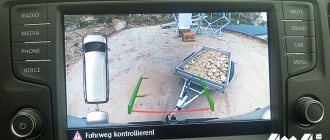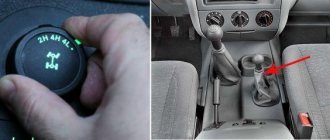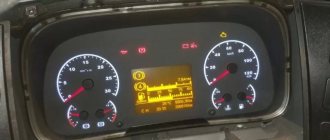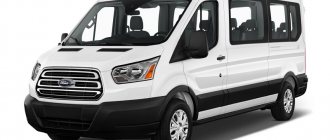The Volkswagen Crafter, produced in Germany since 2006 along with the Mercedes Sprinter, remains a worthy choice today, although its most recent modernization was carried out in 2011.
The Crafter and Sprinter vans are very different, and the main difference is that all VW models have the company's 2.0-litre turbocharged diesel engines with twin-charging technology and BlueMotion under the bonnet, which offer excellent levels of economy and CO2 emissions.
Crafter models are available in different wheelbases, body lengths, roof heights and useful cargo volume. The main body types offered by the Volkswagen Crafter, in addition to the van, are: minibus, pickup truck and chassis.
This vehicle, depending on the version, has a dead weight of 3,000, 3,500 kg or 5,000 kg, which makes it ideal for transporting heavy and bulky cargo.
All used Volkswagen Crafter found on AutoMoto.ua
from $7,836 to $34,995
In many respects, the Crafter van is much better than the Mercedes Sprinter, with which they have the same body and chassis design.
However, if you're looking for an affordable van, the Crafter faces stiff competition from the likes of the Ford Transit and Iveco Daily.
Despite everything, Volkswagen is famous for the reliability of its cars. The Crafter is covered by a 3-year/160,000 km warranty, as is the top model in this market segment, the Ford Transit.
The completely updated Volkswagen Crafter van will be presented in September 2016 in Hannover at the commercial vehicle exhibition.
click on photo to view in full screen mode
See also catalogs:
All Volkswagen Crafter cars (259)
Volkswagen Crafter
Volkswagen Crafter
Volkswagen Crafter
The Volkswagen Crafter is a relatively rare car on Russian roads, but among small-tonnage vehicles from European companies bought new from us, its share is not so small, because most of the almost seven thousand cars registered in our country were sold through official dealers. Comparing statistics at the beginning of this year with data at the beginning of last year (see tables of the analytical agency Autostat), we see that the number of cars has almost doubled in such a short period of time.
Moreover, the highest interest in this model was suddenly shown in St. Petersburg - almost eight hundred new cars were bought there, that is, a third more than in Moscow. Buyers respect the Crafter for its German reliability and excellent engines - advantages for which they are willing to pay more than the cost of French, Korean and Italian light-duty vehicles, which are much more common in Russia. The fact that most of the carriers who have chosen Crafter is concentrated in the financially prosperous Central District is quite natural, and good sales volumes in the Volga region, the Urals and Siberia can be explained by the fact that German equipment is better adapted to cold climates than those made in the south of Europe , and many have heard about the trouble-free start-up of Volkswagen engines in severe frost.
Interior
The interior design of the Volkswagen Crafter can hardly be called attractive, since the decoration uses mostly rather hard plastic in gloomy gray and black shades.
However, this model still has more pros than cons. The branded seats are comfortable and perfect for long trips over long distances. The Crafter's cabin offers plenty of extra storage space for small items, as well as a folding table in the center rear seat area and a storage compartment above the windshield.
Power windows are standard, as is cruise control, but steering wheel height and reach adjustments are only available as an option.
All Volkswagen Crafter vans have a steel partition separating the cab from the load area as standard. For an additional fee, you can get improved partitions with a window and a sliding door.
A wide range of wood and rubber flooring is available for this model, as well as a selection of fiberboard and plywood overlays.
Also, if desired, it is possible to improve the equipment by adding passenger airbags, a rotating rear view camera and a 5.8-inch screen.
Anatomy of the model
Produced since 2006 and undergoing a slight restyling in 2011, the Volkswagen Crafter is still unified in most parts with the similar light-duty Mercedes-Benz Sprinter. In fact, the models differ only in engines, gearboxes, lighting equipment, elements of exterior trim and interior of the cabin. According to an agreement between the two German automakers, they are assembled at the Mercedes-Benz plants in Dusseldorf (all-metal vans and buses) and Ludwigsfeld (chassis and onboard modifications). In the first case, the 11th position of the VIN number contains the number 6, and in the second - 7. The first three positions always contain the code WV1. The designation of the modifications is extremely simple: the rounded gross vehicle weight in hundreds of kilograms is encrypted with a two-digit number, and there are three options in total: 30, 35 and 50. In addition to this marking, there is also a division by body type: Kasten - an all-metal cargo van, Kombi - a cargo-passenger van with a number seats from two to nine, Pritschenwagen - a flatbed truck and Fahrgestell - a chassis for installing a special body or other superstructure.
According to dealer statistics, in Russia more often they buy all-metal 3- and 3.5-ton modifications used as delivery trucks. The demand for 5-ton vans, including those intended for conversion into minibus taxis, is low; in this niche, the similar Sprinter is much more in demand - its emblem looks more solid. It’s even less common to buy a Crafter chassis, because for the same 1.3–1.5 million rubles you can buy, for example, an Isuzu NQR75, which can carry two tons more and has a million-dollar engine. Also, Kombi is almost not in demand here - the lighter T5 is much more relevant as an office minibus, and versions with a larger passenger capacity are unprofitable to import into Russia in finished form.
Exterior
VW Crafter vans are equipped with a wide 1.3m sliding side door, which allows the front loading area to be loaded. Also, two mounting rings are available inside on the side pillars and 6-12 of these rings are located on the floor of the van.
A second sliding side door is available on the driver's side for an additional cost. Also available as an option are automatic side door opening, a wide range of fixed and removable tow hooks, fog and automatic headlights, and rain-sensing wipers.
The Crafter is offered in medium and long wheelbases and two roof options.
There is no auxiliary step in the rear for easy loading of luggage (but it is available for selection), while there is a step in the front bumper. It is included in the standard package as an auxiliary tool, without which it will be extremely difficult for the driver to completely wash the car's windshield.
The design of the Crafter itself can be said to have become much simpler, and the design is more minimalistic than before. During the latest updates, Volkswagen has tried to remove all unnecessary accents from this car.
Opinion
Andrey Ivanov, head of the transport department of City Express, Moscow.
— Our company is engaged in courier delivery of express mail and cargo; the Moscow branch has about thirty light-duty vans in its fleet, including all representatives of the Volkswagen commercial range: Caddy, Transporter, as well as one all-metal Crafter van produced in 2008. We bought it new from an official dealer and use it for one-time transportation of large consignments of cargo. Flights are mainly in Moscow and the Moscow region, but there are also flights to neighboring regions - usually with a return on the same day. The 5-ton modification of the Crafter 50 was chosen based on the large internal volume of the long-wheelbase version with a high roof, rather than its 2500 kg load capacity.
In four years, the car ran about 100 thousand km - there were no major breakdowns or major repairs. We keep it in an open parking lot all year round - in any frost, the engine is guaranteed to start. The only case when the engine did not start immediately was due to the driver’s fault: on Friday evening he forgot to turn off one of the energy consumers, and over the weekend the battery was discharged. Among the minor shortcomings of the car, I note the capriciousness of some elements of electrical equipment in wet and snowy weather. For example, when wet snow hits the ABS wheel sensors, which often happens during snowfall and slush on the road, the warning light on the instrument panel begins to flash. This does not affect the effectiveness of the brakes in any way, and when necessary they operate with consistent reliability. But false failure signals get on the driver’s nerves, and if he strictly follows the safety rules, he must immediately interrupt the flight to find out the cause of the malfunction - brakes are no joke! When the brakes warm up, the warning light goes out. The temperature and engine coolant level sensors behave similarly - apparently, the designers ensured their smooth operation only in fairly mild conditions of the European climate. In our case, as soon as frost hits, the antifreeze shortage lamp lights up on the instrument panel - especially if the car is driving along the highway and cold air intensively passes through the radiator. The driver stops, opens the hood - the fluid level is normal. The “treatment” here is simple: in the old fashioned way, we place a piece of cardboard in front of the radiator, and the electronics stop “going crazy.”
More serious complaints are about the quality of the paint; the enamel is not flexible enough and easily falls off the body along with the primer. It looks like small chips without corrosion of the metal (it is galvanized), which are gradually overgrown with dirt, and our white car takes on an unpresentable appearance. Moreover, for such pinpoint chipping, even a light impact is enough - our cars do not drive on gravel roads, at most - an ordinary “sandblast” from dirty puddles. The fragility of the enamel is typical for all commercial models of the Volkwagen brand, produced by different factories: Crafter (Dusseldorf), Transporter (Hannover) and Caddy (Poznan) - apparently, the paint comes from the same factory. The only thing that helped was “branding” the car: they covered it with a special film in the City Express corporate style; now many organizations offer such services.
While the factory warranty was valid, the Crafter was serviced at the technical center of the official dealer. Then we started going to an independent service center - its services, taking into account the possibility of using non-original spare parts, are much cheaper, and the qualifications of the staff inspire more confidence. Moreover, we have been servicing Caddy and Transporter models there for a long time. Looking back, you wonder: perhaps you should have refused the services of a dealership technical center immediately after purchasing a new car.
Review from the owner of a 2012 Volkswagen Crafter.
Good model
I recently purchased a used Volkswagen Crafter. Vehicle mileage: 138,000 km, fuel consumption: 9 - 13 l, production date: 2012, engine capacity is 109 hp, cargo-passenger body, maximum speed 144 km/h. I had my doubts before purchasing, but now I’m glad I settled on this car.
The Volkswagen Crafter is a rather large car that resembles a truck, but in fact is not one at all. The interior is made in the same way as in conventional passenger cars.
The passenger seats are quite comfortable, there is a lot of space, you can stand up to your full height. This minibus is perfect for short trips, but not for long trips. The seats are not suitable for comfortable long-term trips or travel.
Since the minibus is quite large, it will be quite difficult to find a suitable car wash and its services will cost more. Of course, you can wash the car yourself, but it will take quite a lot of time.
When you first use the car, you may have problems with turns, since the car is quite long (about 7 meters). You need to time the turn at the right time, and then quickly turn the steering wheel to fit into the turn and not hit anything. Therefore, beginners who have not driven such cars before need to be careful when choosing a trajectory. For the rest. The handling feel and other nuances remain the same as in passenger cars.
All trucks are usually designed to constantly carry cargo and therefore, if the body is completely free, they begin to sway and bounce violently on any small imperfections in the road. Due to the long body, the Volkswagen Crafter does not have this problem. The car moves smoothly, which is very comfortable.
The cargo body is quite voluminous, there is a lot of space inside, it allows you to transport large loads, in my case up to 1 ton. The presence of cargo does not at all affect the dynamics and smoothness of the car, but it becomes a little easier to drive.
Advantages and disadvantages of the car
In the end, it’s worth summarizing all of the above and identifying the main disadvantages and advantages of this car.
Advantages:
- The interior is comfortable, the same as in passenger cars.
- There is plenty of space inside the passenger and cargo beds. You can stand it upright without any problems, there is also plenty of space around the seats.
- It is convenient to travel in a Volkswagen Crawfter car both in the city and outside the city.
- The car moves smoothly along the road with or without load.
Flaws:
- The problem is washing the car. You will need to find a suitable car wash, it will also cost more and take longer.
- Beginners will find it difficult to corner at first.
Return to reviews
Crafter 35 Kasten, long wheelbase, extended overhang, extra high roof
Crafter 35 Kasten, long wheelbase, extended overhang, extra-high roof
Crafter 35 Kasten, long wheelbase, extended overhang, extra-high roof
The load capacity range of all-metal Crafter vans is from 680 to 2710 kg with useful volumes from 7.5 to 17 m3. There are three wheelbase options: 3250, 3665 and 4325 mm, for the latter there is a choice of regular and increased rear overhang, which gives a total of four body length options. And three roof height options (low, high and extra high) allow you to precisely select the volume of the van at the required length. At the same time, the Crafter 30 comes only with a short and medium wheelbase, with a low and high roof. The “thirty-fifth” has all the options for bases and heights, and even an extended rear overhang, and the “fiftieth” has everything the same, except for a short wheelbase. In addition, the Crafter 50 differs from less heavy-duty versions by its dual-pitch rear wheels.
The latter circumstance may not suit some buyers from the provinces, who in winter have to drive on roads that are not cleared of snow. In this case, we can recommend the 4.6-ton version of the “fiftieth” with single tires size 285/65 R16, which pass through loose snow (and in the summer through clay “porridge”) much more successfully than double tires. But you will have to order such a car individually and wait longer than usual, because the typical “fiftieth” that our dealers bring comes with a double-pitch tire. Apparently, there is a fear that not all Russian carriers will want to buy rather expensive special super single tires, designed for almost double the load - after all, such models of rare demand are not presented in the catalogs of many competing sellers. It is likely that the owner will put regular tires on the rear of a 4.6-ton car, but will load it in accordance with the rated load capacity. As a result, under an unfortunate combination of circumstances (hot weather, a slightly overinflated cylinder, plus a series of intense braking), tire explosions and severe injuries to pedestrians passing nearby are quite likely. A few such cases are enough for the Crafter to acquire a reputation as a “killer car,” which is not at all in the interests of the respected German company, so its decision to supply us with a “fiftieth” with gable rear wheels is humanly understandable.
Opinion
Viktor Sechin, technical director, Moscow.
— As a rule, during the first three, and often even five to six years of operation, the Volkswagen Crafter can serve almost without fail - to do this, it is enough to regularly bring the car to an authorized service center for service. Problems begin if owners, after the end of the warranty period, begin to use oils and non-original spare parts not recommended by the factory - for reasons of economy. And on new cars - install any additional equipment outside dealer service centers, for example, security systems, air conditioners, audio equipment, etc. We have to eliminate the consequences of unqualified intrusion into the complex electrical circuit of a modern car, and there are many such cases.
According to reviews from our customers, the Crafter updated in 2011 is noticeably more economical to operate than the previous one due to not only lower fuel consumption by the 2-liter engine, but also an increased service mileage of up to 20 thousand km. The latter circumstance does not mean that, having gone to the next maintenance, you can forget about the technical condition of the car for a long time - it always needs the owner’s care. It happens that we recommend that the owner arrive earlier - for example, if the stock of brake pad thickness is not enough until the next scheduled maintenance. As a rule, it is possible to estimate the normal rate of wear on a particular car quite accurately, but the client decides whether to come specifically for replacement after, say, 6 thousand km. If the route is not close - from a neighboring region - it will apparently be more profitable and more convenient to install new pads right away. Brake discs are much more expensive, but they also need to be changed in a timely manner, and, alas, not all car owners understand this. The thickness of the new one is 28 mm, and with the remaining 25 mm, the disc is considered extremely worn. If you do not replace it in time, the correct operation of the floating bracket will be disrupted, and the piston boot may rupture and subsequent replacement of an expensive assembly. With the gradual improvement in the quality of diesel fuel sold in Moscow, expensive repairs of the fuel system are becoming a thing of the past - over the past six months we have had virtually no cases of a Crafter arriving with faulty Common Rail system injectors. Failures are mainly associated with the use of winter fuel additives - of course, which have not received approval from Volkswagen.
The drug poured into the tank often clogs the fuel filter, after which the car is brought to us by tow truck. Diagnostics show a lack of pressure in the line after the booster pump, and, as a rule, it is possible to return the car to operation simply by replacing the filter and flushing the fuel system. But in general, the engines that are installed on the Crafter now (2-liter) and were installed previously (2.5-liter) are extremely reliable, cases of their premature overhaul are extremely rare. I don’t remember that we repaired gearboxes and drive axles—these units can only be damaged intentionally. We have never changed the springs - both rear and transverse in the front suspension. The service life of the clutch greatly depends on the driving style and the region in which the car is used. If the Crafter is from the outback, where you have to rock it out of the mud or snow, the driven disk can last less than 100 thousand km, and for metropolitan cars that quickly start from traffic lights, premature replacement of the dual-mass flywheel is more typical - its damper is destroyed, which causes knocking at idle and when starting off. For thrifty drivers, both the clutch and the flywheel last for years.
Opinion
Egor Sochnev, Head of Corporate Department
— In 2011, the Volkswagen Crafter received a 2-liter engine. Thanks to the reduction in displacement, all four versions with a power of 80, 100, 105 and 120 kW are now distinguished by outstanding efficiency - fuel consumption has decreased by an amount from 1.2 l/100 km (for 80 kW) to 2.1 l/100 km (for 120 kW version). That is, the latter in the combined cycle consumes an average of only 7.7/100 km with CO2 emissions of 203 g/km. Taking into account the increased reliability of engines and the additional reduction in maintenance costs (the service mileage increased by 5 thousand km), the carrier’s operating costs were reduced by approximately 10%. Moreover, compared to the previous 2.5-liter of the same power, the torque of the new engine has increased from 360 Nm to 400 Nm - this is the best indicator in its class. In addition, a slight increase in load capacity - up to 90 kg depending on the model - was also useful, partly due to the use of a lighter 4-cylinder engine. Nevertheless, some buyers who already had positive experience in operating Volkswagen Crafter light-duty vehicles had mixed reactions to the reduction in the number of engine cylinders, but after a detailed acquaintance with the advantages of the new unit, the questions disappear.
One of the benefits of Volkswagen vehicles that customers value is their virtually unlimited customization. The client’s desire is the law for us, and if he has chosen any configuration option or option that is not included in the standard list for delivery to our market, his order will still be fulfilled - just in a slightly longer time. For example, we’ll bring him a very rare Crafter 50 for Russia with single rear wheels.
Driving impressions
The Volkswagen Crafter offers comfortable handling, strong brakes and an elevated driving position that provides a good view of the road. While driving, the car turns quite confidently, accurately and with minimal body roll.
Despite the lower rated engine power compared to the Master or Transit, the Crafter has good top speed and acceleration from the starting position.
The standard manual transmission is quite stiff and has sharp gear changes. But, unfortunately, for this model, unlike the Sprinter and Fiat Ducato, a robotic dual-clutch or automatic transmission is not available.
The basic configuration of the Crafter includes an electronic stability control and stabilization system. This puts the VW on par with the Mercedes Sprinter and Ford Transit, and even a step above the Opel Movano, which only offers these systems as standard on rear-wheel drive models. The Volkswagen Crafter also has brake force distribution and traction control systems that do an excellent job with their intended purpose - to help the driver control the vehicle's movement on slippery surfaces.
We take care of it from a young age
As the experience of carriers shows, despite the almost “passenger” design with a monocoque body, independent front suspension on arms stamped from sheet metal and a transverse fiberglass spring, all this, at first glance, does not cause the slightest problem - the chassis lasts for years, without requiring replacement parts. The gearbox and final drive reducer are almost indestructible. The durability of the latter is evidenced by the design itself - the Crafter is equipped with a rear axle of the “spicer” type, which, to repair the gearbox, must be removed from the vehicle entirely, having previously “stretched” the springs. But you will hardly have to do this if you don’t get carried away with driving on muddy or snowy primers (the driven gear bearings don’t like being pulled back and forth), pulling the car while rocking, and regularly monitor the cleanliness of the axle breather so that the unit does not lose oil through the seals . However, after a run of 100 thousand km, the neck of the gearbox may begin to sweat. In this case, it is better to replace the drive gear flange seal in advance and forget about it until the next five digits on the odometer are reset.
The excellent starting qualities of the engine should not, however, mislead the owner of the car - the Germans did not at all conceive the Crafter as a conqueror of the icy winter roads on the Yenisei. Finding itself in extreme weather conditions, it can initially delight with its reliability and survivability, and then suddenly “fall to pieces.” According to several scenarios. For example, on the highway in frost below minus 30 degrees, water condensate in the engine breather often freezes, when the heat from the engine (after all, this is a modern, economical diesel engine) is not enough for all surfaces of the unit to have a positive temperature. This will be followed by an increase in pressure in the crankcase, squeezing out oil through the front oil seals and getting it onto the timing belt. It’s good if the latter, simply slipping when adding gas, jumps one or two teeth, and the driver, sensing something is wrong (loss of power, smoke from the muffler), stops and catches the tow. In the worst case, not only the valves bend, but also one or two connecting rods... The belt can jump over the teeth of the crankshaft pulley even when cranked with the starter - on a frosty Siberian morning, if the owner spared money on expensive oil of 0W30 viscosity class. It’s even worse if, due to a “sticky” camshaft, the belt does not jump, but by pulling the roller, the tin clamp that fits into the hole in the block straightens it. Then the crankshaft will definitely make a couple of full revolutions regardless of the camshaft, grinding everything that will interfere with it in this activity...
And, of course, every buyer of a light-duty truck with a diesel engine and a timing belt - even if he lives in sunny Sochi - must understand that starting the engine from a tug must be forgotten once and for all. That is, to be aware that the designers’ efforts to create a belt as durable as a chain, crowned with victory, were fully appreciated only by Europeans blissful in their ideal climate. For them, the belts with a service life of 200–240 thousand km, which appeared six years ago, really became a gift, allowing the first buyer there to shift the replacement of this “consumable” onto the shoulders of the second. Our realities are different, and therefore there is a whole class of carriers (apparently those who have already been “burnt” once) who, when choosing a light-duty truck, consider models only with “chain” engines (Sprinter, Transit, Boxer, Jumper, 3-liter Daily ).
Another technical innovation of the last two decades is the widespread introduction of dual-mass flywheels with a built-in non-repairable damper on diesel engines. That is, the old cast-iron “pancake” has ceased to be eternal, and for some drivers who adore a sporty driving style, it has moved into the category of “consumables”. Therefore, if you have your clutch replaced after driving 80–100 thousand km, listen to the advice of the service station technician and replace the flywheel too - while everything is disassembled and the gearbox is lying on the floor. Do you feel sorry for an extra thousand euros? So you will still have to give it back - maybe in a couple of months, when the flywheel starts knocking. Only then will you once again pay 5 thousand rubles for the work and again lose a whole day in idle time. Particular attention to the machine operated in the provinces. It’s enough to refuel once in the wrong place, and new injectors will cost more than 100 thousand rubles. Against the backdrop of such costs, replacing ball joints broken by potholes or stabilizer pads eaten from constant bouncing will seem like a pittance.
Volkswagen Crafter: expensive, but cheerful










